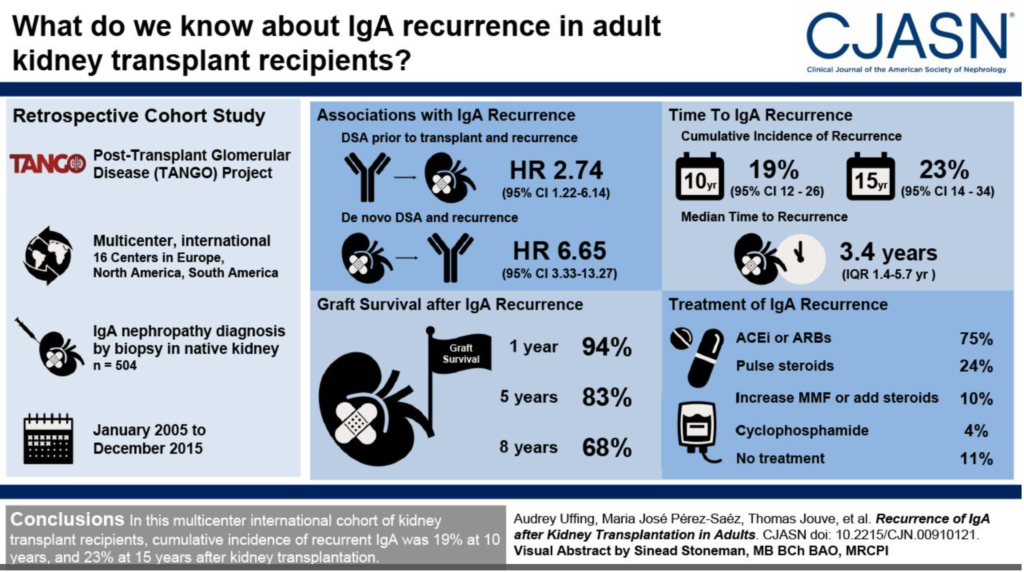Clin J Am Soc Nephrol. 2021 Aug;16(8):1247-125
Authors:
Uffing A, Pérez-Saéz MJ, Jouve T, Bugnazet M, Malvezzi P, Muhsin SA, Lafargue MC, Reindl-Schwaighofer R, Morlock A, Oberbauer R, Buxeda A, Burballa C, Pascual J, von Moos S, Seeger H, La Manna G, Comai G, Bini C, Russo LS, Farouk S, Nissaisorakarn P, Patel H, Agrawal N, Mastroianni-Kirsztajn G, Mansur J, Tedesco-Silva H, Ventura CG, Agena F, David-Neto E, Akalin E, Alani O, Mazzali M, Manfro RC, Bauer AC, Wang AX, Cheng XS, Schold JD, Berger SP, Cravedi P, Riella LV.
Abstract:
Background and objectives: In patients with kidney failure due to IgA nephropathy, IgA deposits can recur in a subsequent kidney transplant. The incidence, effect, and risk factors of IgA nephropathy recurrence is unclear, because most studies have been single center and sample sizes are relatively small.
Design, setting, participants, & measurements: We performed a multicenter, international, retrospective study to determine the incidence, risk factors, and treatment response of recurrent IgA nephropathy after kidney transplantation. Data were collected from all consecutive patients with biopsy-proven IgA nephropathy transplanted between 2005 and 2015, across 16 “The Post-Transplant Glomerular Disease” study centers in Europe, North America, and South America.
Results: Out of 504 transplant recipients with IgA nephropathy, recurrent IgA deposits were identified by kidney biopsy in 82 patients; cumulative incidence of recurrence was 23% at 15 years (95% confidence interval, 14 to 34). Multivariable Cox regression revealed a higher risk for recurrence of IgA deposits in patients with a pre-emptive kidney transplant (hazard ratio, 3.45; 95% confidence interval, 1.31 to 9.17) and in patients with preformed donor-specific antibodies (hazard ratio, 2.59; 95% confidence interval, 1.09 to 6.19). After kidney transplantation, development of de novo donor-specific antibodies was associated with subsequent higher risk of recurrence of IgA nephropathy (hazard ratio, 6.65; 95% confidence interval, 3.33 to 13.27). Immunosuppressive regimen was not associated with recurrent IgA nephropathy in multivariable analysis, including steroid use. Graft loss was higher in patients with recurrence of IgA nephropathy compared with patients without (hazard ratio, 3.69; 95% confidence interval, 2.04 to 6.66), resulting in 32% (95% confidence interval, 50 to 82) graft loss at 8 years after diagnosis of recurrence.
Conclusions: In our international cohort, cumulative risk of IgA nephropathy recurrence increased after transplant and was associated with a 3.7-fold greater risk of graft loss.

